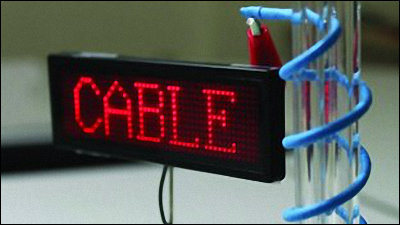Why is 'mAh' not a suitable unit of battery capacity?

When comparing the battery capacity of smartphones, mobile batteries, etc., 'mAh / Ah (milliampere hour / ampere hour)' is generally used. However, iFixit, which sells device disassembly information and repair tools for smartphones, explains that mAh is not actually suitable for comparing battery capacity.
What Is mAh and Why Is It Bad for Measuring Battery Capacity? - iFixit

The photo below is a portable battery from iFixit. This portable battery is said to be able to fully charge a smartphone with a 5000mAh battery two or three times, but the correct mAh value is only 5200mAh. The reason for the confusion that a 5200mAh portable battery can charge a 5000mAh smartphone two or three times is that the technically correct usage of mAh to express discharge capacity and the colloquial usage to express energy capacity (battery capacity) are mixed.

Originally, mAh is a unit that expresses 'how much current can be discharged per hour (discharge capacity)'. In other words, if you have a '5000mAh' battery, it means that it can discharge 5000mA of current for 1 hour, and if the current is 2500mA, it can discharge for 2 hours. However, when most people see the unit 'mAh' in relation to a battery, they tend to think that it refers to the 'battery capacity' itself.
For example, if you see descriptions like 'iPhone 12 Pro Max with 3687mAh battery,' '2000mAh rechargeable AA batteries,' and '9000mAh
The reason is that to express the energy capacity, it is necessary to consider not only mAh but also the ' nominal voltage (V) '. The nominal voltage represents the average voltage while the battery is in operation and is one of the characteristics related to the battery's performance. The nominal voltage is listed on the package, and if you look at the package of the replacement battery for the iPhone 12 Pro Max below, you can see that the nominal voltage is '3.83V'.

The true capacity of a battery cannot be known without looking at not only mAh but also the nominal voltage. This relationship is easier to understand if you think of the mAh value as the difference between S/M/L sizes of clothing and the nominal voltage as for men/women.
For example, even if it is the same 'M size', if it is 'for men' it is generally larger than 'for women'. Therefore, unless you are comparing batteries of the same type with the same nominal voltage, comparing battery capacity in mAh does not work properly.
As an example, iFixit cites a scenario comparing 'alkaline AA batteries', 'rechargeable AA batteries (nickel-metal hydride batteries)', and 'lithium-ion batteries'. Because these batteries have significantly different chemical compositions, their nominal voltages are 'alkaline AA batteries: 1.5V', 'nickel-metal hydride batteries: 1.25V', and 'lithium-ion batteries: 3.6V', respectively. Therefore, even if all of them are labeled as 2400mAh, a '2400mAh lithium-ion battery' has about three times the battery capacity of a '2400mAh nickel-metal hydride battery'.
Also, packing the same number of batteries in different arrangements will not change the overall battery capacity of the pack. As shown below, a pack of six batteries arranged in two rows of three, a pack of three rows of two, and a pack of six batteries in series all have different mAh and nominal voltages, but the overall battery capacity of the pack is the same.

Manufacturers understand that mAh is not a good way to accurately express battery capacity, but it is just confusing to general consumers if they appeal to mAh and nominal voltage. Therefore, manufacturers use a number called 'colloquial mAh' that treats the entire battery installed in the device as 'a huge lithium-ion battery with a nominal voltage of 3.6V'. This allows consumers to compare the size of batteries just by comparing 'mAh'.
Thus, the confusion between the technically correct mAh used as discharge capacity and the colloquial mAh used to refer to battery capacity has confused many people, iFixit points out.
Therefore, iFixit argues that it is better to use 'watt-hours (Wh)' to compare battery capacity between different products. Wh can be calculated by dividing mAh by 1000 and multiplying it by the nominal voltage. In other words, the watt-hours of a battery with a discharge capacity of 5200mAh and a nominal voltage of 10.8V are as follows.
5200÷1000×10.8=56.16Wh
iFixit says it's fine to use the colloquial term mAh to describe battery capacity as long as you're aware of the assumptions and limitations it comes with, but advises that if you're comparing mAh between two batteries and one value seems artificially high or low, it's best to look at the nominal voltage and calculate the watt-hours to compare.
◆ Forum is currently open
A forum related to this article has been set up on the official GIGAZINE Discord server . Anyone can post freely, so please feel free to comment! If you do not have a Discord account, please refer to the account creation procedure article to create an account!
• Discord | 'How do you think it is appropriate to express battery capacity specifications?' | GIGAZINE
https://discord.com/channels/1037961069903216680/1288060153773424722
Related Posts:
in Hardware, Posted by log1h_ik







